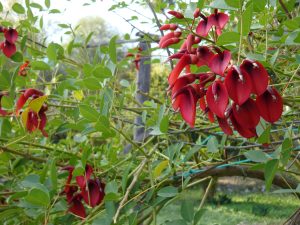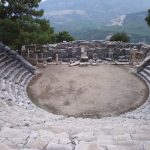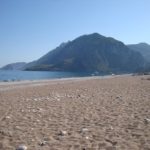Water-logged archaeological beauty
Old name: Zemuri (Lycian)
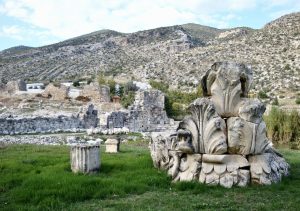 Heading inland from Finike on the Mediterranean coast, you can hardly miss Limyra as a lengthy stretch of the ancient city wall stands right beside the road, together with a ticket booth that may or may not be staffed.
Heading inland from Finike on the Mediterranean coast, you can hardly miss Limyra as a lengthy stretch of the ancient city wall stands right beside the road, together with a ticket booth that may or may not be staffed.
A gate in the wall leads through to an unexpected expanse of water meadow where, to the rear, you’ll spot a cenotaph (empty tomb) standing on a stone plinth. It was placed there in memory of Gaius Caesar, grandson of the Roman emperor Augustus and his presumed heir, who died here in 4 AD (by which time the site at Limyra was already more than 400 years old).
Far more visually appealing is a ruined temple, also on a plinth, which stands right beside the footpath. If you skirt round the base of this it’s rather like stepping through the back of the wardrobe into Narnia – except that in this case you step into what looks like a Constable painting of the English countryside around Flatford Mill, complete with a stream, copious deciduous trees and low stone bridges. What makes Limyra unusual is that it was built beside a river at the point where a spring emerged from Tocak Dağı (Mt Tocak) and bubbled up right beside the municipal buildings. Today you can make out what looks like the floor plan of a basilican church just beneath the water, while the columns of the temple had to be erected on the plinth to keep them dry.
Seemingly, people used to come here to find out what the future held for them by throwing meat to a fish oracle like the one at the Letoon. According to Pliny, if they ate the meat this suggested a rosy future while if they turned their backs on it things were looking grim.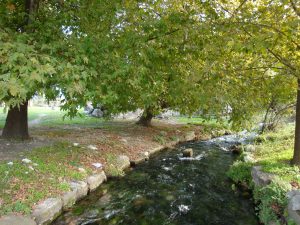
There’s not a lot else to see here although many huge chunks of marble masonry lie scattered on the ground and the spot is so idyllic that you might want to linger for a picnic. But just a short walk away you can explore an all-but-forgotten Roman theatre standing right beside the road which leaves it vulnerable to graffiti artistes and pesky wannabe guides.
A little further along the main road if you look up to the left you will see a fine Lycian sarcophagus standing amid pomegranate, fig and tangerine trees. More rock-cut Lycian tombs lurk in the back garden of a house almost hidden in vegetation across the road from another stretch of city wall.
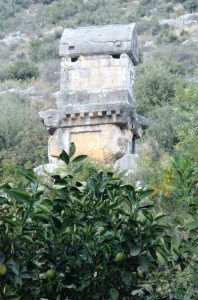 Then you will come to the shrine of a Bektası saint, Kati Baba, which overlooks a small pond and what looks like either another rock-cut tomb or perhaps a niche where a cult object might once have been placed.
Then you will come to the shrine of a Bektası saint, Kati Baba, which overlooks a small pond and what looks like either another rock-cut tomb or perhaps a niche where a cult object might once have been placed.
Sleeping
There is accommodation in Elmali and Finike although for a better choice you may want to press on to Antalya.
Transport info
To get to Limyra without your own car you need to get to Finike on the road from Fethiye to Antalya. From outside Finike’s small otogar you can pick up minibuses heading north to Turunçova. There you switch to a second minibus to get to nearby Limyra. Ask to get out as soon as you see the ruins beside the road.
Driving, you might want to press on north to the even more impressive ruins at Arykanda.
